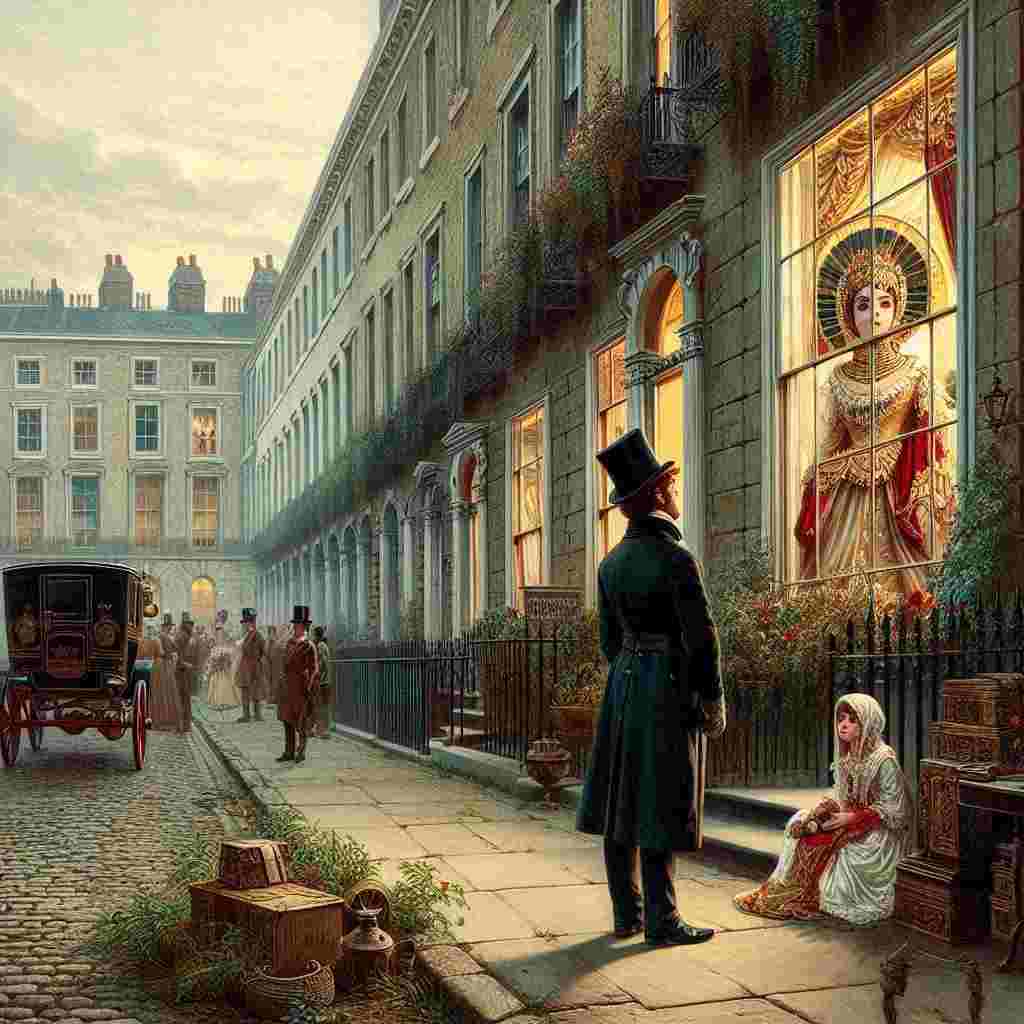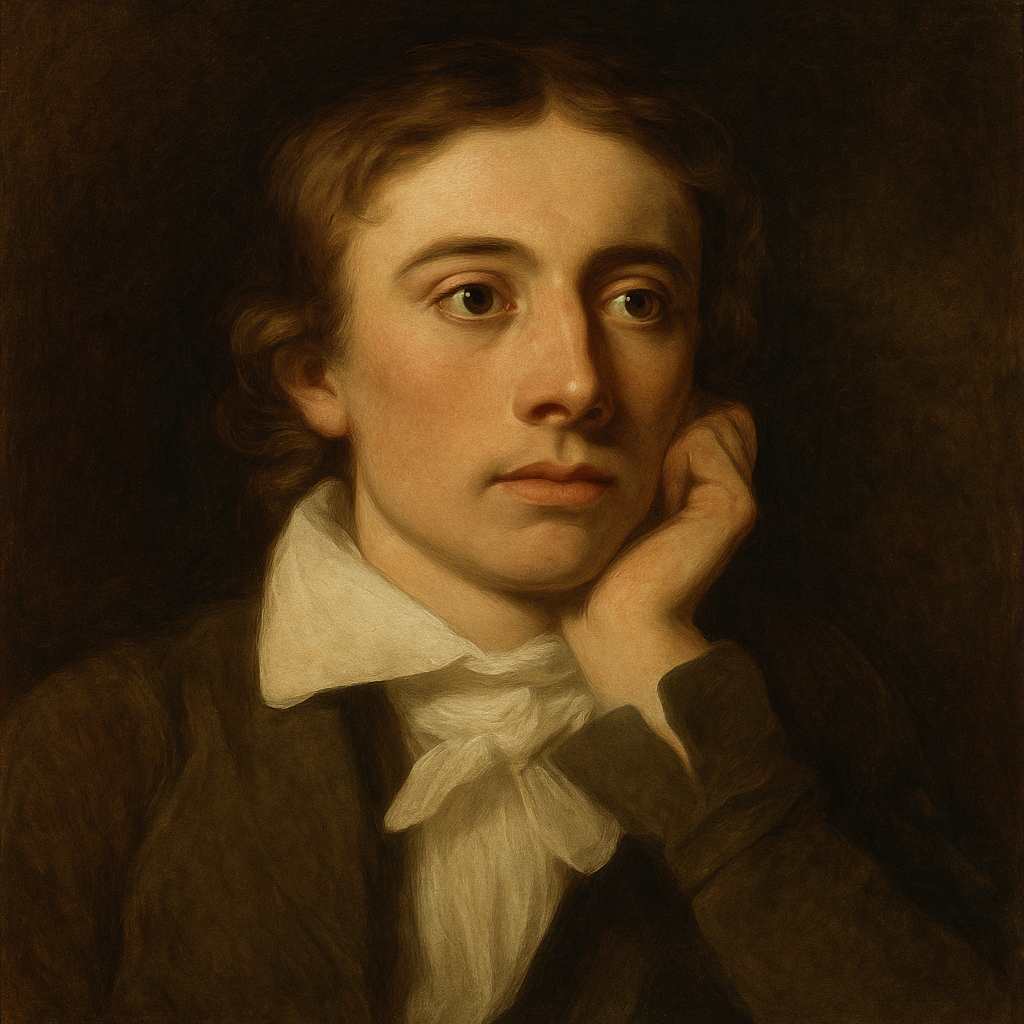Modern Love
John Keats
1795 to 1821

And what is love? It is a doll dress’d up
For idleness to cosset, nurse, and dandle;
A thing of soft misnomers, so divine
That silly youth doth think to make itself
Divine by loving, and so goes on
Yawning and doting a whole summer long,
Till Miss’s comb is made a pearl tiara,
And common Wellingtons turn Romeo boots;
Then Cleopatra lives at number seven,
And Antony resides in Brunswick Square.
Fools! if some passions high have warm’d the world,
If Queens and Soldiers have play’d deep for hearts,
It is no reason why such agonies
Should be more common than the growth of weeds.
Fools! make me whole again that weighty pearl
The Queen of Egypt melted, and I’ll say
That ye may love in spite of beaver hats.
John Keats's Modern Love
Introduction
John Keats, one of the most celebrated English Romantic poets, is renowned for his sensual imagery and exploration of deep emotions. However, his poem "Modern Love" presents a striking departure from his usual style, offering a satirical and critical view of romantic love. This essay delves into the complexities of Keats's "Modern Love," examining its structure, tone, imagery, and thematic implications to uncover the poet's commentary on the nature of love in his contemporary society.
Structure and Form
"Modern Love" is composed of 17 lines of blank verse, deviating from Keats's more common use of formal structures like sonnets or odes. This choice of form reflects the poem's content, which challenges conventional notions of love. The lack of a rigid rhyme scheme mirrors the poet's rejection of idealized romantic conventions, while the iambic pentameter maintains a sense of poetic tradition, perhaps ironically so.
The poem's structure can be loosely divided into three parts: the opening definition and mockery of love (lines 1-8), the middle section critiquing societal obsession with romance (lines 9-12), and the final segment challenging the reader and offering a conditional resolution (lines 13-17). This tripartite structure mimics the development of an argument, reinforcing the poem's satirical and didactic tone.
Tone and Voice
From the outset, Keats adopts a sardonic and dismissive tone, immediately challenging the reader with the rhetorical question, "And what is love?" The answer that follows is laden with contempt, describing love as a "doll dress'd up / For idleness to cosset, nurse, and dandle." This infantilizing imagery sets the stage for a scathing critique of romantic love as a frivolous and immature pursuit.
The voice in the poem is that of a cynical observer, possibly reflecting Keats's own disillusionment with romantic ideals. The repeated use of "Fools!" in the latter part of the poem emphasizes this critical stance, directly addressing and chastising those who subscribe to superficial notions of love.
Imagery and Symbolism
Keats employs a range of vivid imagery to convey his critique of modern love. The opening metaphor of love as a dressed-up doll suggests artificiality and childishness. This is further developed with "soft misnomers," implying that the language of love is fundamentally misleading.
The transformation of everyday objects into romantic symbols - "Miss's comb" becoming a "pearl tiara" and "common Wellingtons" turning into "Romeo boots" - satirizes the way infatuation distorts perception. These images underscore the poem's theme of love as a form of self-delusion.
The references to Cleopatra and Antony, juxtaposed with mundane modern addresses, serve multiple purposes. They highlight the gap between romantic ideals and everyday reality, mock the tendency to elevate ordinary relationships to mythic proportions, and perhaps comment on the commercialization of romance in urban settings.
The "weighty pearl" in the final stanza alludes to the famous story of Cleopatra dissolving a valuable pearl in vinegar to win a bet with Mark Antony. This historical reference adds depth to the poem's exploration of love's value and the lengths to which people will go for it.
Thematic Analysis
At its core, "Modern Love" is a critique of the superficial understanding and pursuit of love in Keats's society. The poem suggests that contemporary notions of love are childish, self-indulgent, and divorced from reality. By describing love as something "divine / That silly youth doth think to make itself / Divine by loving," Keats mocks the idea that romantic love is a path to transcendence or self-improvement.
The poem also explores the commercialization and trivialization of love. The transformation of everyday objects into romantic symbols can be read as a commentary on how consumer culture co-opts and cheapens genuine emotion. This idea is reinforced by the domestication of mythic lovers like Cleopatra and Antony, reduced to living in ordinary London neighborhoods.
Keats challenges the ubiquity of romantic love in popular culture and literature. By stating that the intense passions of "Queens and Soldiers" are "no reason why such agonies / Should be more common than the growth of weeds," he questions why love should be considered a universal experience or the highest form of human connection.
Historical and Biographical Context
Understanding "Modern Love" requires considering Keats's personal experiences and the broader cultural context of the Romantic era. Written in 1819, the poem reflects a period when Keats was grappling with his own romantic feelings for Fanny Brawne. The cynicism expressed in the poem might be seen as a defense mechanism against the vulnerability of deep emotional attachment.
Moreover, the Romantic period was characterized by an emphasis on intense emotions and individual experience. "Modern Love" can be read as a reaction against these very ideals, showcasing Keats's ability to critique the movement he was part of. The poem's focus on urban settings and consumer goods also reflects the rapidly changing social landscape of early 19th-century England.
Literary Devices and Techniques
Keats employs various literary devices to enhance the poem's impact. The use of enjambment throughout the poem creates a conversational flow that contrasts with the elevated language, reinforcing the tension between romantic ideals and mundane reality.
Alliteration, such as "doll dress'd" and "cosset, nurse, and dandle," adds a mocking musicality to the verse. The caesura in line 13 ("It is no reason why such agonies") creates a pause that emphasizes the shift in the poem's argument.
The poem's final line, with its reference to "beaver hats," employs synecdoche to represent the mundane, everyday world that stands in opposition to romantic idealization. This concrete image serves as a grounding counterpoint to the mythic allusions earlier in the poem.
Comparative Analysis
"Modern Love" stands in stark contrast to many of Keats's other works, such as "Ode on a Grecian Urn" or "La Belle Dame sans Merci," which often treat love and beauty with reverence. This departure highlights Keats's versatility as a poet and his ability to adopt different perspectives on similar themes.
The poem's satirical approach to love bears similarities to works by Keats's contemporary, Lord Byron, particularly in poems like "Don Juan." However, where Byron's satire often retains a sense of playfulness, Keats's critique in "Modern Love" is more biting and dismissive.
Conclusion
"Modern Love" showcases John Keats's ability to subvert expectations and critique societal norms. Through its scathing tone, vivid imagery, and complex allusions, the poem presents a multifaceted analysis of love in the modern world. Keats challenges his readers to look beyond the superficial trappings of romance and question the value placed on love in popular culture.
The poem's enduring relevance lies in its exploration of how genuine emotion can be distorted by social expectations and consumer culture. By ending with a conditional statement - "make me whole again that weighty pearl... And I'll say / That ye may love in spite of beaver hats" - Keats leaves the door open for a more authentic understanding of love, one that transcends the trivialities of fashion and social convention.
Ultimately, "Modern Love" invites us to critically examine our own conceptions of love and the influences that shape them. It stands as a testament to Keats's intellectual depth and his ability to engage with complex emotional and social issues, cementing his place not just as a master of beauty and sensuality, but as a keen observer and critic of human nature and society.
This text was generated by AI and is for reference only. Learn more
Want to join the discussion? Reopen or create a unique username to comment. No personal details required!



Comments
No comments yet. Be the first to comment!